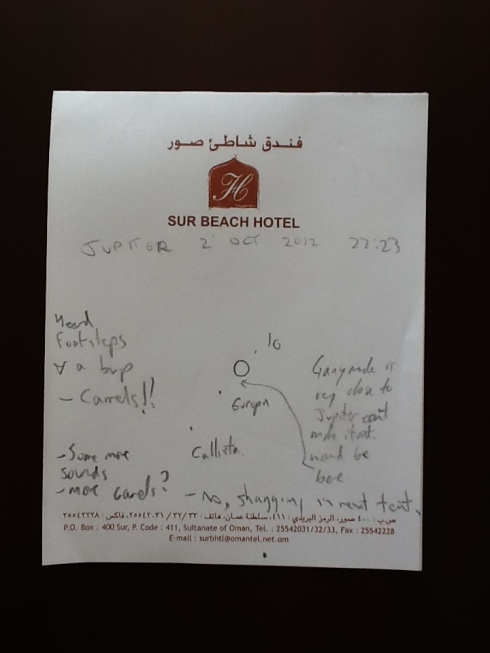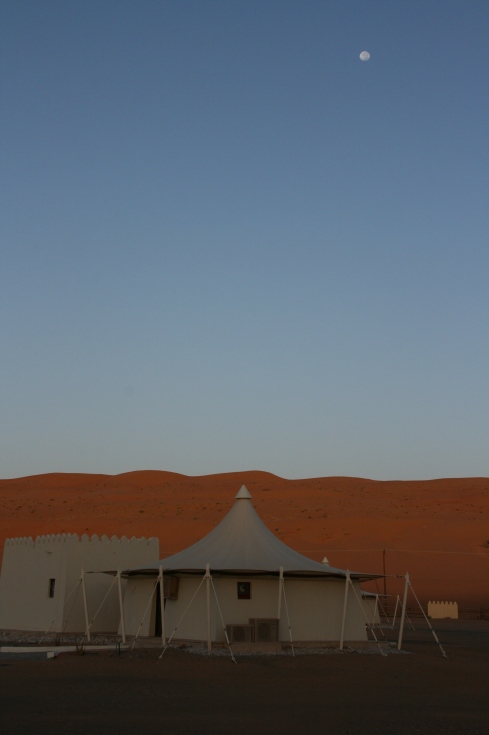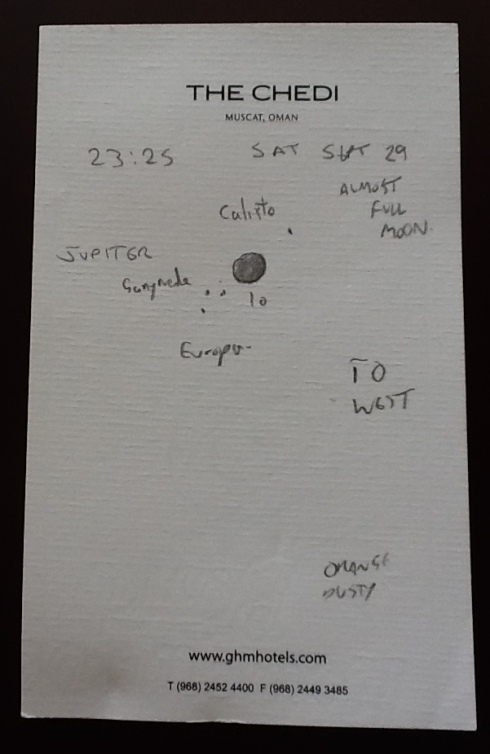Location: Desert Night Camp, Wahiba Sands, Oman
Conditions: Clear, dark. No cloud, no mist, no haze.
Highlights: Dark Skies, Milky Way, Mare Criseum, The Desert
I’d really been looking forward to our stay in the desert in Oman. We stayed at the marvellous Desert Nights Camp in the Wahiba Sands region. It was great fun driving 11km into the desert with our 4×4 Land Cruiser drifting through the sands.
After settling into our luxurious tent they took us up onto the dunes to watch the sun set.

19:00 By 7pm it was dark. I’d expected dark clear skies but this was incredible. Before my eyes more detail came into view minute by minute. I used the Summer Triangle to get my bearings. The Milky Way was visible stretching through Cassiopeia in the East, Cygnus at the zenith and to Sagittarius in the West.
I had the binoculars with me and I also had my Canon EOS400D on the tripod to take some long exposures for potential processing and stacking later. However I was more interested in just viewing the spectacle of it with the naked eye and had a bit of a wow moment at the detail I was seeing.

19:30-20:00. the moon rose at about 8pm. It was about 3 days past full and very bright, again washing out the sky and lighting the camp. This was a major shame as a lot of the detail was lost to me and the Milky Way pretty much disappeared from view. I could discern it in places but that might have been more of a case that I was expecting to see it there.
21:45 Before booking the Desert Night Camp I’d been in contact with them by email and they had told me they had a telescope I could borrow when I visited. When we checked in, it was there in reception a 114mm newtonian with a 1000mm focal length in a shortish tube – a parabolic mirror I guess. They told me it wasn’t working but I was welcome to try it. I think they hoped I might be able to fix it. After dinner (which was great, although I thought the ice sculpture was a bit over the top. The Oud player was brilliant though – unusual stringed instruments – another of my interests) I went to check it out but couldn’t get anything out of it. I suspect the collimation was way out. It had probably been fiddled with by a well meaning enthusiastic amateur trying to fix it. I hadn’t really got the skills, equipment or time to do much with it and figured I was wasting my time and would be better off with my binoculars instead.
I spent some time observing the moon – 2/3 days past full so some detail along terminator. The Mare Criseum was a standout and the walls around it formed a horseshoe with the upper edges of those extending like two horns into the darkness. I was using my Cambridge Star Atlas to identify the lunar features. The numbers refer to the numbering in the Star Atlas. Of particular note were the rays from Proclus. This is number 12 on the Lunar 100. This takes my tally up to 8/100.
There was also a distinctive line of 4 craters along the terminator – Petavius, Snelius, Stevinus and Rheita.

22:15 I observed the Andromeda Galaxy, M31 through the binoculars. Really impressive.
Jupiter rose above the Eastern dunes and once again I sketched the positions of it moons to compare their progress from night to night. I could only see 3 of the Galilean moons this evening as Ganymede was really close to Jupiter and i was unable to discern it.
I’d given up on the tripod for the binoculars as lengthy viewing was giving me some neck ache. Instead I was outside our tent on a beanbag. There wasn’t anybody else about. There weren’t many other people at the camp and it’s not a place for late night drinking and partying. I heard a burp footsteps nearby behind me and turned to see two camels wandering through the camp. A little later I heard some more grunting sounds and thought the camels were back. However it was just a couple in a nearby tent shagging.

05:30 The following morning we were up early at 5:30 to catch the sunrise over dunes.
By now it was getting light and only planets were visible to the naked eye. Jupiter was up at the zenith. Venus was to the east. Observing it through the binoculars showed a bright star nearby which A spotted when she took a look. This was Regulus in Leo which was within about 8 arcminutes and this conjunction had been mentioned in the highlights for the month in various publications and podcasts. Closest approach was 3 October so this was a fortunate treat. I hadn’t been looking for it.

The moon was also still up now over in the Western sky.

Observing programs
Messier: 7/110
Lunar 100 observed: 8/100
Lunar 100 imaged: 8/100
Tags: Andromeda, camels, conjunction, desert, desert night camp, Jupiter, mare Criseum, Milky Way, Moon, Oman, Regulus, Venus, Warhiba Sands





















![My Broken Heart [Explore 15/5/24] My Broken Heart [Explore 15/5/24]](https://live.staticflickr.com/65535/53722911143_d5a75671ec_s.jpg)


